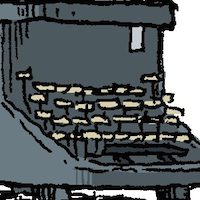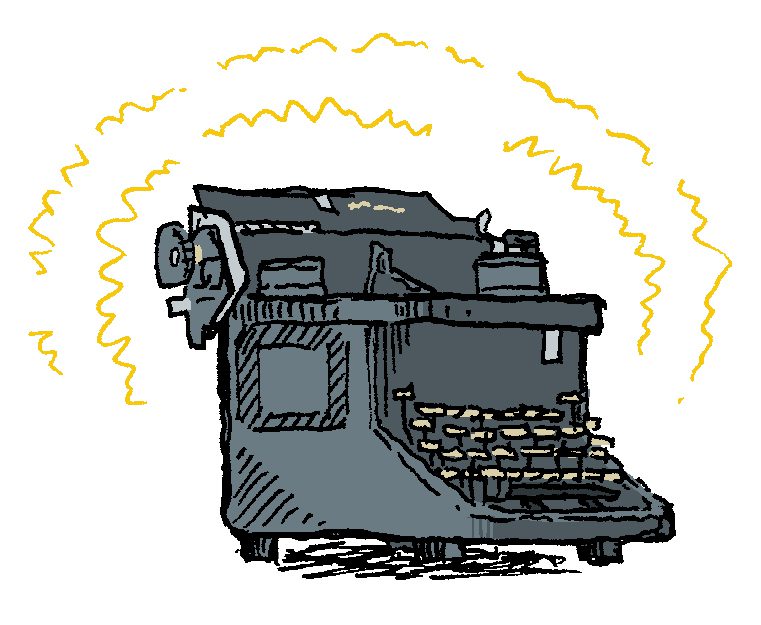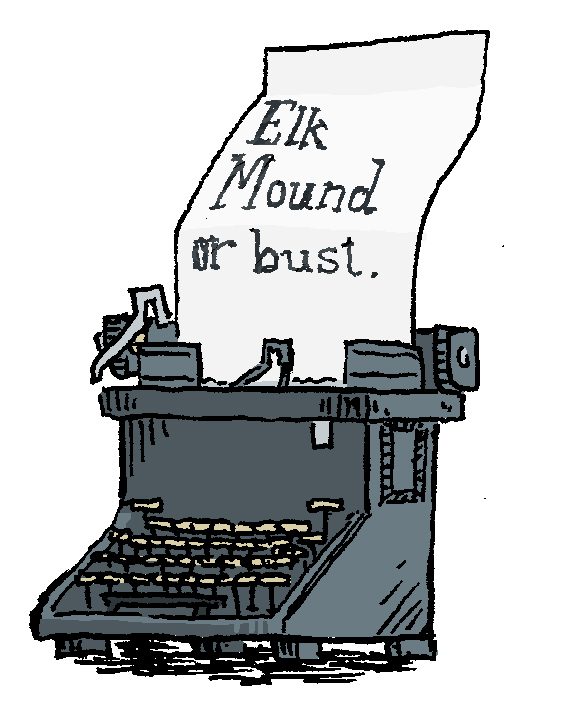
On the cusp of my 30th birthday and just days before the birth of our second child, I decide to do the practical thing and purchase a pair of nonfunctioning typewriters.
The first might’ve been chalked up as an impulse buy, though when I buy the second half an hour later, it becomes evident that the only impulse I seem to possess is to ignore the voice that tells me to quit buying typewriters.
This voice belongs to my wife.
She’s waiting in the van with our two-year-old son when I pop the trunk and slip the second machine alongside the first.
“What’d you get?” she asks me.
I stay quiet.
“Jesus, its not another typewriter?”
I stay quieter.
The drive home goes mostly as expected:
Yes, I tell her, of course I am of sound mind.
And:
Sure I’m in control of my faculties.
Though the problem—which she is quick to point out—is that my recent actions hardly confirm any of this.
The elephant in the room is our son in his car seat and our daughter still in her womb—both of whom will one day require at least a good faith effort at a college fund. To my wife’s credit, she spares me her “priorities” lecture, which keeps me from delivering the one I’d titled: “Think of Them As An Investment.”
Of course, I never thought of my typewriters so crassly. Rather, I saw them for what they really were: mint-conditioned artifacts documenting the history of the written word.
When I break the silence and mention this to my wife during the drive home (“They’re our Rosetta Stones to the past!”), she makes a remark about me being the one who is stoned.
While my second purchase—a 1950s-era Remington Quiet Riter—filled me with not-so-quiet joy, it was the first purchase—a Woodstock No. 5— that soon became my darling.
When I first laid eyes upon her at the garage sale, I knew she had to be mine. There was something about her carriage release lever, her platen knob, which made it impossible for me to leave her there on that trailer alongside the pedestrian hand tools.
As my wife and son bickered over which book to buy from the dollar bin, I forked over a cool twenty and never looked back.
“What do we have here?” my wife inquired, her eyebrow adrift as I lumbered toward them.
“She has a name,” I said. “It’s Woodstock.”
*
Woodstock was born in Woodstock, Illinois in 1921. Though the company began as the Emerson Typewriter Company in 1907, it was soon sold to Sears, Roebuck & Company, then sold again to the Woodstock Typewriter Company in the wake of World War I.
 According to the 1923 issue of Typewriter Topics, the Woodstock was quick to gain a reputation for being “easy and convenient to use”—primary selling points for many first time typewriter owners. Thanks to improvements to the original design, the Woodstock was no longer some metal-mouthed creature to be feared. Now it was sleek (sort of), reliable (sometimes), and the envy of typewriter enthusiasts (somewhere).
According to the 1923 issue of Typewriter Topics, the Woodstock was quick to gain a reputation for being “easy and convenient to use”—primary selling points for many first time typewriter owners. Thanks to improvements to the original design, the Woodstock was no longer some metal-mouthed creature to be feared. Now it was sleek (sort of), reliable (sometimes), and the envy of typewriter enthusiasts (somewhere).
As I clutched all 35 pounds of my newly purchased Woodstock, I didn’t much care about American’s past perceptions of the brand; all I cared about was this particular typewriter’s story.
Where had she been, what had she typed, and who had done the typing?
Prior to my wife’s eyebrow-drifting inquiry, I’d turned to the woman working the cash drawer and asked what she could tell me about my purchase.
“Not much,” she said. “I think it came from an estate sale in Elk Mound, but that’s about all I know.”
I kept pressing—Who’s estate? Do you have an address?—until finally, after exhausting her patience, she directed me to a man in a red shirt on the opposite side of the lawn.
“Why don’t you ask Chris?” she said at last. “It used to belong to his grandparents.”
I approached the man, smiling as widely as possible without appearing threatening.
“Hi, there,” I said, slouching beneath Woodstock’s weight. “Mind if I ask you a few questions?”
*
If Woodstock still worked, her output would look something like this:
The quick brown fox jumps over the lazy dog.
Note the typeface, the tracking, the line, the length, and the lead. The way the o’s are dark pupils, while the p’s and d’s are dark pupils connected to sticks. Note the monospaced spacing as well, and how everything from the slight “i” to the wandering “k” receives the same real estate. And perhaps most marvelous of all: the way the Roman type maintains the illusion of stability, even amid the spongy splotches.
Had Woodstock’s typebars not been gummed, I’d have been blessed daily with her beautiful blot, taking every opportunity to type a postcard, a grocery list, a letter to a long forgotten friend. But since most of Woodstock’s keys pushed back, I received no output for my efforts. These days, I am sad to report, Woodstock serves best as a paperweight.
But when Chris Meyer was a boy, Woodstock was far more than any paperweight. In the early 1970s, her keys still struck, and on occasion, Chris would catapult her arms toward the paper spooled into the platen. Had he felt compelled, Chris could’ve tested every last letter by typing the pangram involving the quick brown fox and the lazy dog. But he didn’t. There was little time for typewriters given his responsibilities assisting his grandparents, Melvin and Elise, in operating their 120-acre dairy farm.
In the rare moment after every last cow had been milked, Chris would occasionally sneak up the attic stairs to pound at the smooth, round keys. But eventually Chris grew up, the typewriter grew older, and all the quick brown foxes stopped jumping.
“Anyone ever use the typewriter other than you?” I ask him.
“You know,” Chris says, “not that I can remember.”
To the best of his knowledge, Woodstock gathered dust in his grandparents’ attic in Elk Mound, Wisconsin for close to 50 years. Cows came and went, crops came and went, but the typewriter always remained.
In 1993, after Melvin passed and Elise downsized to a smaller farmhouse a mile or so down the road, the typewriter came with her. It was lugged down the attic stairs and placed in the milk house adjacent to Elise’s barn.
There, Woodstock remained for another 20 years—enduring blizzards and droughts—until Elise moved once more, this time to an elder care living facility.
When her house sold in the spring of 2014, Chris returned to the property one last time to pack up his grandmother’s things. He peeked inside the milk house, spotted Woodstock, and figuring somebody might want her, placed her alongside the hand tools on the back of the trailer to be driven to the garage sale in Eau Claire.
Which is where I enter the scene: smiling as widely as possible without appearing threatening.
*
While I quickly dispatch of the mystery of Woodstock’s 12-mile journey from Elk Mound to Eau Claire, the greater mystery remains: How had she managed the 268-mile trek from Chicago to Elk Mound?
 I search Woodstock for signs, running my hands over her solid body as I crouch in my garage, pressing every last key in the hopes of unearthing some previously overlooked clue.
I search Woodstock for signs, running my hands over her solid body as I crouch in my garage, pressing every last key in the hopes of unearthing some previously overlooked clue.
But the only clue I unearth needs no unearthing; it’s staring me straight in the face.
Directly to the left of Woodstock’s logo (featuring Hermes, messenger of the gods) are two letters scrawled in dark ink.
The first letter is an uppercase “L” followed by what appears to be a lowercase “t.”
Initials, I think, perhaps for Woodstock’s owner prior to the Meyers.
My mind runs through a list of possibilities for “Lt”:
Lieutenant, Looney Tunes, Lake Tahoe, Lithuania…
With little to go on I take to the newspapers, searching through a century’s worth of Eau Claire back issues to find ten total mentions of Woodstock typewriters. After subtracting the Associated Press reports on the Alger Hiss story (a man made famous in the HUAC era for allegedly using a Woodstock to type State Department secrets), the remaining mentions are mostly ads for estate sales.
In each, the ad mentions the names of the estate’s owners, though I’m discouraged to learn that no estate with a Woodstock ever belonged to a person with the initials “Lt.”
Delving deeper into the local newspaper archive, I find that the first mention of a Woodstock typewriter was printed on August 31, 1921, an advertisement introducing the world (or at least western Wisconsin) to the brand.
But what catches my attention isn’t the ad, but its sponsor—the Eau Claire Book and Stationary Company.
Maybe, I think, Woodstock was purchased there.
After paging through city directories from the era, I learn that the Eau Claire Book and Stationary Company on Barstow Street was but one of many places in town where one could purchase a Woodstock. One could just as easily have patronized Mac’s Typewriter Company (also on Barstow), or perhaps the Eau Claire Press Company (also, inexplicably, on Barstow).
These days, the brick buildings on Barstow Street are no longer glutted with typewriters. Instead, they’re glutted with law offices, a pizza joint, and a children’s museum.
The only place in town that might still sell a Woodstock today is the antique store (also, of course, on Barstow); a three-story cabinet of curiosities complete with two-headed calf taxidermy, African art, and more mothballed postcards than even I—an avid collector—knows what to do with.
I call the store one day, not to buy another typewriter—(I am allowed but one existential crisis per decade, my wife informs me)—but to tell the proprietor of my dear Woodstock, and to ask if she might have any information on her.
Surely, I think, if anyone cares about a 93-year-old typewriter, it’s the woman on the other end of the line.
But she is not interested.
She is the opposite of interested.
“We wouldn’t know anything,” she says. “I mean, it’s just some old typewriter, right?”
My gasp, I’m sure, is audible.
*
Since my typewriter store trail seems to have run cold, I try another tack: returning my attention to the Meyers. On a map, I try to pinpoint which of the many Barstow locations might’ve been most convenient for Melvin, try to imagine what it might’ve looked like for that man to walk into a store between milkings, pull out his wallet, and inquire about the latest in typewriter technology.
I admit it’s not an easy scene to envision. Ever since Chris informed me that neither of his grandparents ever went out of their way to actually use Woodstock, it’s hard to rationalize why they might have gone out of their way to buy her.
Unless, I think, they didn’t go out of their way.
I return once more to the city directories, where I soon learn that Melvin Meyer’s occupation is listed not only as a dairy farmer, but also a printer for a local business, Shedd-Brown Manufacturing.
The rabbit hole widens.
Where there are printers, I reason, mustn’t there also be type? And where there is type, mustn’t there be…
I call up Chris, ask him if he thinks it’s possible that his grandfather simply purchased Woodstock from Shedd-Brown; if, for instance, after a long day of printing stationary or wedding invitations, he eyed her in the showroom and first held her in his arms.
“You know,” Chris says, pausing, “now that you mention it, that’s very possible.”
It is possible, I agree, but that doesn’t explain the mystery of the initials.
Who in the world was “Lt”?
*
Maxine Brown was born in Eau Claire, Wisconsin in 1925, four years after Woodstock. She spent her life here—married here, worked here, and in 2011, at the age of 86, died just a few miles up the road. Her obituary indicates that she was active in her church, worked at the Wisconsin Department of Taxation, as well as a stint at Shedd-Brown Manufacturing.
The obituary also mentions that Maxine was the daughter of Louise Tollefson.
My mind bends and retracts, trying hard to unravel the scenario to its conclusion.
Okay, I think, so maybe Maxine’s mother Louise gives her daughter a hand-me-down typewriter with her initials on it. And since Maxine doesn’t have much use for it, maybe she mentions it to her co-worker, Melvin—whom she knows is a printer—figuring he may have an interest in the machine. And maybe Melvin does. Maybe he takes it off her hands, gives it a whirl, places it in the attic of his farmhouse in Elk Mound…
Of course, I think, my eyes widening. Now it all makes sense!
But of course it doesn’t—not in the least.
Indeed, it is one scenario among many, though there are far too many variables left unaccounted for, too many uncertainties to ever deem it true.
Chief among them: I have no earthly idea whether Louise Tollefson ever owned a Woodstock (or even a typewriter, for that matter). Nor am I certain that her daughter Maxine crossed paths with Melvin at their shared workplace. And who’s to say the letters “Lt” are initials, and even if they are, who’s to say they belonged to a previous owner?
Even as I poke holes in my theory, the illogical part of me persuades the other part that my story must be true.
It simply has to be.
After all, I’ve been dreaming of typewriters for weeks and my mind is in desperate need of a connection. I’m not picky; most any connection will do.
 And so, I rearrange the clues like moveable type until I find a sentence that almost makes sense. I go with my gut, hone my hunches, take illogical leap after illogical leap like some reckless, high-flying squirrel.
And so, I rearrange the clues like moveable type until I find a sentence that almost makes sense. I go with my gut, hone my hunches, take illogical leap after illogical leap like some reckless, high-flying squirrel.
And I’m not alone in my leap-taking.
Keep in mind that once upon a time a quick brown fox jumped over a lazy dog.
And keep in mind also that that sentence once held meaning for me, as it did for others.
When I first saw the pangram I read it literally, wholly naïve to its function as a key test.
Who was that fox? I wondered. Who was that dog? Why was one quick and one lazy?
Only later did I learn that it wasn’t the sentence’s narrative that mattered, but the function behind those carefully selected words, the test those letters performed.
Today, months’ removed from my initial fervor, I can’t help but wonder if perhaps my beloved Woodstock is no different than that fox and dog: just some test for calibration.
Just some cold machine whose splotch and blot always proves humbling, gumming the message we like to think we see.
***
Rumpus original art by Peter Manges.




